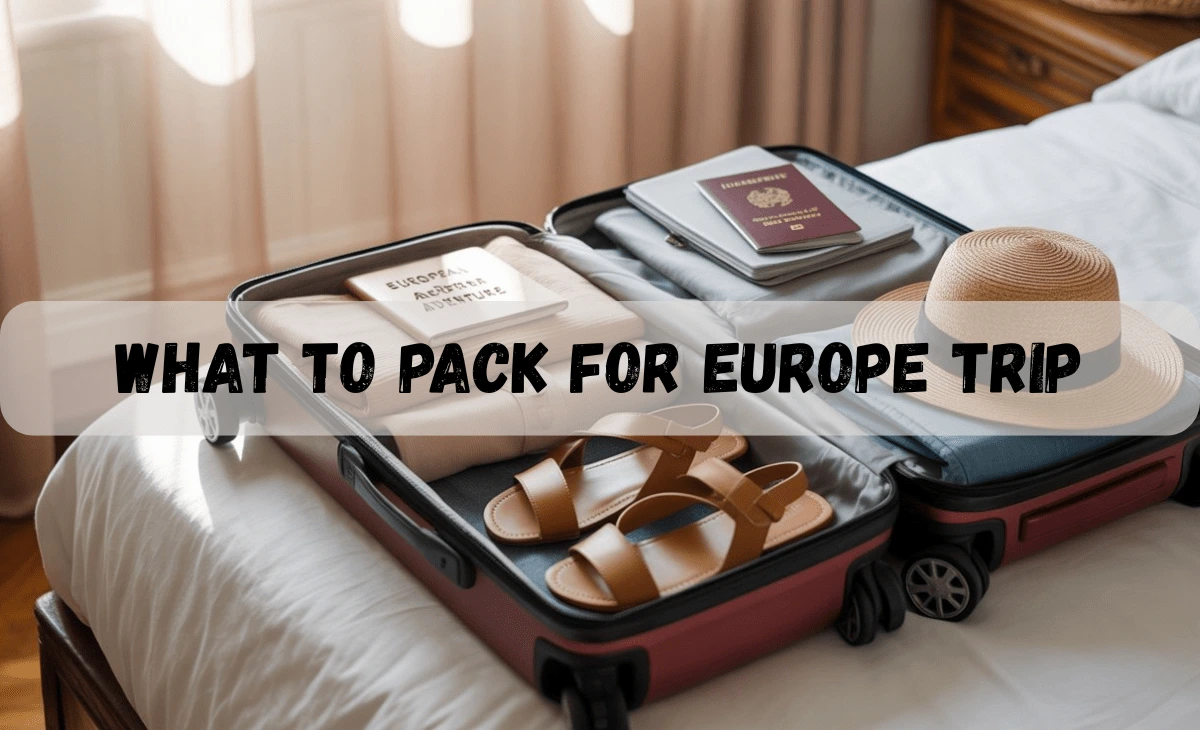Planning a Europe trip is exciting but knowing what to pack for Europe trip. From navigating different climates to preparing for diverse activities, packing right ensures your journey is smooth, enjoyable, and stress-free. Whether you’re backpacking through hostels, enjoying a luxury escape, or mixing city tours with countryside hikes, having the right essentials can make all the difference.
This comprehensive guide is designed to help travelers like you understand what to pack for europe trip based on real travel experiences, smart planning strategies, and practical considerations. Let’s dive into what you really need and what you can leave behind.
Why Packing Right for Europe Matters
Europe offers a variety of experiences from ancient cities and scenic countryside to alpine hikes and Mediterranean beaches. Each country has unique weather patterns, cultures, and expectations, making a universal packing list nearly impossible.
The key to mastering your packing list is flexibility and intention. This guide will help you:
Avoid overpacking and unnecessary baggage fees
Stay comfortable across different climates and regions
Prepare for a mix of formal, casual, and outdoor events
Keep essentials organized and accessible
Essential Clothing to Pack for Europe
The golden rule for European travel: pack layers, not bulk. What to pack for europe trip can be unpredictable, especially during shoulder seasons (spring and autumn). Here’s what you’ll need for most travel plans:
Base Layer Essentials
- Comfortable T-shirts or breathable tops (3–5)
- Long-sleeve shirt or blouse for layering
- A light sweater or fleece for warmth.
- Undergarments and socks for 5–7 days
Outerwear Choices
- Lightweight waterproof jacket or windbreaker
- An insulated jacket is recommended if you are traveling during the fall to spring seasons.
- Scarf or shawl useful for warmth and church visits
Bottoms & Dresses
- 2–3 pairs of pants (jeans, trousers, leggings)
- 1–2 pairs of shorts or skirts (for summer trips)
- Casual dress or outfit for dinners or nights out
Footwear
- Comfortable walking shoes (essential for cobblestone streets)
- Sandals or slip-ons (for warm days or hostel showers)
- Dress shoes or boots (optional, for formal occasions)
Pro Tip: Europeans tend to dress smart-casual. Leave athletic wear and flip-flops for the beach.
Travel Gear and Luggage Tips
Choosing the Right Luggage
Selecting the best luggage depends on your travel style:
Backpack (40–50 L): Ideal for budget travelers or multi-country trips with lots of train travel
Rolling suitcase (carry-on size): Great for short trips or city-based vacations
Daypack or sling bag: Necessary for day trips and city exploration
Make sure your luggage is durable, lightweight, and meets airline size restrictions.
Must-Have Travel Accessories
Packing cubes: Keep clothes organized and save space
Laundry bag: Useful for separating dirty clothes
Compression bags: Great for bulky items like jackets
Money belt or RFID pouch: Added security for passports and cards
Travel pillow and sleep mask: Especially for long-haul flights or trains
Tech and Electronics to Bring
Even minimalist travelers will want to bring a few electronics:
Universal travel adapter: Essential in Europe, where plug types vary
Smartphone + charger: For navigation, translation, and communication
Portable power bank: Keep devices charged on the go
Camera (optional): For high-quality travel photography
Earphones or noise-cancelling headphones: Ideal for flights or busy hostels
Tip: Download offline maps (Google Maps or Maps.me) and translation apps before departure.
Important Documents and Travel Essentials
Never leave without these key items, and always back them up:
- Passport + copies (digital and physical)
- Travel insurance policy
- Flight/train/bus tickets
- Accommodation confirmations
- Credit/debit cards + local currency
- If applicable, bring your EU digital health certificate or vaccine record.
Store originals in a secure location and keep photocopies or scans in your email/cloud storage.
Toiletries and Personal Care items
Many personal care items what to pack for europe trip stores, but it is wise to bring travel-sized versions:
Toothbrushes, toothpaste, and floss
Shampoo, conditioner, body wash.
Razor and shaving cream
Deodorant
Sunscreen and lip balm with SPF
Makeup (optional)
Menstrual products (if applicable)
Prescription medications (with doctor’s note)
Pack liquids in a clear quart-sized bag to meet airline requirements.
Seasonal Packing Advice
Summer (June–August)
Expect hot weather, crowded cities, and lots of walking.
- Breathable clothing
- Sunhat and sunglasses
- Reusable water bottle
- Cooling towel (for heatwaves)
Winter (December–February)
In winter, Europe can be cold and wet, particularly in northern countries.
- Insulated coat
- Thermal base layers
- Gloves, hat, and scarf
- Waterproof boots
Shoulder Seasons (Spring & Autumn)
Unpredictable temperatures pack for layers and occasional rain:
- Light waterproof jacket
- Sweater and scarf
- Comfortable, weather-resistant shoes
Real-Life Packing Example: 2-Week Europe Trip
Traveler Profile: 28-year-old solo female traveler visiting France, Italy, and Germany in spring.
Luggage: 45L backpack + 15L daypack
Key Items Packed:
4 tops, 2 pants, 1 dress, 1 light jacket, 1 fleece, 7 undergarments.
Sneakers, sandals
Toiletry kits, adapters, and power banks
Travel documents, smartphones, and journals
Scarfs, foldable umbrellas, and packing cubes
Outcome: Comfortable, stylish, and fit within budget airline carry-on limits.
Common Packing Mistakes to avoid.
Overpacking: You’ll regret lugging heavy bags on trains or cobblestone streets.
Ignoring airline restrictions: Many European budget airlines have strict size/weight policies.
Forgetting essentials like adapters: Not all countries use the same plugs.
Packing valuables in checked luggage: Always carry them in your hand luggage.
Not preparing for rain: Umbrellas or rain jackets are crucial in Europe.
FAQs About What to Pack for Europe Trip
What is the best bag for traveling Europe?
A carry-on-sized backpack or suitcase is ideal for flexibility, especially on trains and budget airlines.
How many outfits should I pack for two weeks in Europe?
Plan to pack 5–7 outfits that can be mixed and matched, and consider doing laundry mid-trip.
Should I bring jeans to Europe?
Yes, jeans are common in Europe, but bring lightweight ones for comfort.
Do I need travel insurance for Europe?
Yes, travel insurance is highly recommended for health, theft, or cancellations.
Can I use my phone in Europe?
Check with your carrier. Many offer affordable international plans. Alternatively, buy a local SIM card or eSIM.
Read Also: Travel Palm Plant Care & Benefits: Your Complete Indoor Guide
Conclusion: Travel Light, Travel Smart
What to pack for europe trip doesn’t have to be stressful. With smart planning, the right gear, and flexible clothing options, you’ll be ready for anything from Parisian cafés to Alpine hikes. Remember less is more. Focus on essentials, plan for laundry, and always leave room for souvenirs.
Ready to start your adventure? Bookmark this guide and start packing confidently for your unforgettable Europe journey!


